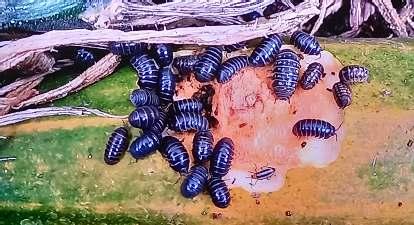These little garden creatures are quite unique in that they are actually isopods and part of the crustacean family who have gills even though they live on land but can easily drown if submerged in water. They do need adequate moisture to survive or their gills dry out and they suffocate.
Generally, they are nocturnal and like to hide under rocks, rotting wood/logs and damp, dark places during the day. They feast on decaying plant matter the same as earth worms but live on the soil surface and therefore, assist in promoting the development of top soil. It is also believed that they reduce heavy metal ions in the soil so, ultimately, they can be very beneficial to our gardens because they usually don't cause many problems. However, they can nibble on new seedlings or stems if they can't find enough food so, if they cause any problems, a solution is easily at hand by placing a collar around new plants or simply removing the majority from your bed. A simple way is to place potato peel, soft moisture filled fruit such as melon, orange, etc in a toilet roll, leave on surface for a day then remove and relocate to another garden, compost heap or feed to chicke ns. If they are not eating your plants, just leave them be to decompose matter back into your garden or become food, themselves, for birds, frogs, lizards, etc. so they become an important part of a permaculture cycle. If their numbers are too great, you could sprinkle diatomaceous earth on the soil or spray plants with neem oil.
I have never heard of an animal/creature with such a vast array of names. Here are 15 out of the 30 names I found:
- Australia/NZ - Slaters, roly polies and butchy boys (the name l called them growing up)
- USA - Armadillo bugs, doodle bugs, pill bugs, roly polies, potato bugs, sow bugs.
- UK - Billy buttons, cheesy bugs, chisel bobs, chuggie pegs, gramersows, monkey peas.
Thank you
Happy gardening

